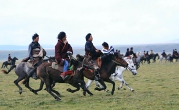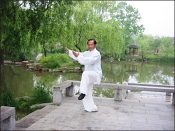China Overview
- Population: 1.3 billion
- Currency: yuan
- Guinness World Records: most people painting each other's faces simultaneously in one location (13,413), largest bottle of cooking oil (containing 3212 litres), most couples hugging (3009 couples).
- Internet users: 135 million
- Milk beer: from Inner Mongolia, an alternative to the traditional mare's-milk wine.
- Squirrel fish: whole mandarin fish deep-fried and manipulated to resemble a squirrel.
- Number of chinese characters: over 56,000
index
Brief Introduction to Chinese Traditional Sports and Activities
Chinese traditional sports and activities are very popular, and as are also a precious cultural heritage for the country, which has existed since ancient times. Many of the traditional sports activities are not only good for health but also have high artistic value, and rich recreational and educational functions. These sports include martial arts, taijiquan or shadow boxing, qigong (a system of deep breathing exercises), Chinese chess and weiqi and encirclement chess. | |
How did Chinese traditional sports and activities come into existence? |

| It is inevitable that with such a long history, China should have developed several unique and traditional sports and pastimes. Almost all the traditional sports were derived from productive activity, the Mongolians, Tibetans and Kazaks inhabit vast natural grasslands, and the gift for riding and shooting is vital to their existence. Consequently this has given rise to their forms of sport —horsemanship. |
The people who live in agricultural communities or who rely on hunting for their livelihood are good at climbing, wrestling, jumping and shooting. |
| What is Chinese Kong Fu? | Chinese Kung Fu, also called “martial art”, combines exercise and the arts of self-defense, and is greatly enjoyed in China. Martial arts include bare-handed boxing as well as offence and defense with equipment, both of which has different schools and moves. | |
| What is Tai Ji Quan? |
Tai Ji Quan, which is also known as Chinese shadow boxing, is a major division of Chinese martial art. Tai Ji Quan means "supreme ultimate fist", and is a kind of Chinese boxing, combining control of breath, mind and body. It emphasizes body movement, following mind movements, tempering toughness with gentleness and graceful carriage. The traditional legend goes that the wise man, Zhang Sanfeng of the Song Dynasty (960-1279), created Tai Ji Quan after he witnessed a fight between a sparrow and a snake. |  |
| Most people agreed that the modern Tai Ji Quan originated from Chen style Tai Ji Quan, which first appeared during the 19th century in the Daoguang Reign of the Qing Dynasty (1644-1911). |
| What is Qinggong? |
This is a system of deep breathing exercises, and is a unique Chinese way of keeping fit. It aims at enhancing health, prolonging life, curing illnesses and improving physiological functions by concentrating the mind and regulating the breath. |
Alcohol and Art |
As China is so large, various minorities are separated by huge distances, and it is therefore not surprising that they have their own special ways in which to express their vigor and enthusiasm.There are various entertaining and competitive sports activities in the minority-inhabited areas; |
These include; Mongolian wrestling, horsemanship and archery; kicking the shuttlecock and tug-of-war of the Hui; Tibetan yak racing; the Miao people’s swinging and dragon-boat racing; the Zhuang people’s throwing balls made of colored silk; Korean swinging and see-sawing; Manchu skating; walking on stilts of the Dong people; whipping tops of the Yao people; kite-flying of the Gaoshan; girl chasing of the Kirgiz. These minority sports and activities are an integral part of Chinese customs and culture , enriching the Chinese traditional sports and activities. | |
Dragon boat racing, flying kites, yangge dancing, weiqi, qigong and taijiquan are traditional sports and are popular among both Han people and people of national minorities. |
More about Chinese traditional Sports and Activities

HOTMost Popular Topics

There is no sincerer love than the love of food.

Because of its size, China has great climatic diversity. Generally, the best time to visit China is during spring and autumn.

Chinese is the most commonly used language in China, and one of the most commonly used languages in the world.

China has many traditional festivals, including the Spring Festival, the Lantern Festival, the Dragon Boat Festival.

In the Chinese zodiac, twelve animals are used to denote the year of a person's birth: rat, ox, tiger, rabbit, dragon.

China, one of the world's most ancient civilizations, has a recorded history of nearly 4,000 years..